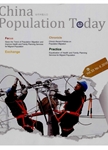The Status and Role of Women
The Status and Role of Women出 版 物:《China Population Today》 (当代中国人口(英文版))
年 卷 期:1994年第11卷第3期
页 面:13-16页
学科分类:0302[法学-政治学] 03[法学] 1002[医学-临床医学]
主 题:Asia Behavior China Demographic Factors Developing Countries Eastern Asia Economic Factors Employment Status--women Family And Household Family Characteristics Family Relationships Income Income Distribution Inequalities Infant Mortality Mortality Population Population Dynamics Psychological Factors Sex Preference Socioeconomic Factors Socioeconomic Status Sons Value Orientation Women's Status
摘 要:Women have enjoyed equal legal rights with men in politics, culture, education, work, property, marriage, and the family since the founding of the People s Republic in 1949. In 1949, 90% of Chinese women were illiterate; in 1992, the illiteracy rate for women dropped to 32%, whereas for males it was only 13%. In 1992, the proportion of women employed outside the home accounted for 72% of the total female population aged 15 years and older and 44% of the total number of employees. The total number of urban women employees increased from 600,000 in 1949 to 56 million in 1993. In urban areas, women generally receive 77.4% of the pay given to men; in rural areas, women receive 81.4%. The infant mortality rate dropped from 200/1000 in 1949 to 31.4/1000 in 1992. Life expectancy for women has risen dramatically from 36.7 years in 1949 to 72 years in 1992. Nevertheless, there is still relatively high mortality among female babies aged 0-4 years; and since the 1950s, there has been a major decline in the proportion of women breast-feeding their babies in both rural and urban areas. Over the past 4 decades, the mean age at first marriage has been increasing, and the majority of women now make their own decision regarding their marriage partners. China currently has 267 million families, and every year, about 10 million newly-wed couples are added to that figure. When the Eighth National People s Congress (NPC) was convened in 1993, women deputies accounted for more than 21% of the total. More than 300 women have been elected mayor or deputy mayor of China s 517 cities. In rural areas in particular, more opportunities for education and employment are given to sons, owing to traditional misconceptions and the need for boys to help on the farm. The All-China Women s Federation has organized women s groups. In the rural areas, women are being encouraged to obtain more education and develop skills.



